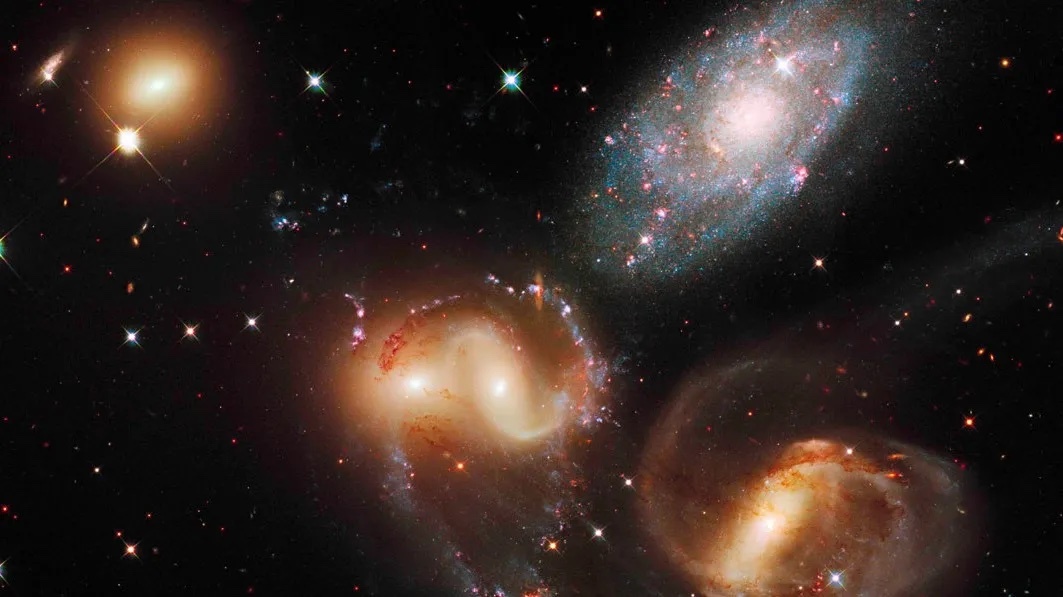16.09.2023
Astronomers normally observe galaxies by observing light these objects emit, but some tricky galaxies require a different approach.

A galaxy grouping called Stephan’s Quintet, which contains an imposter galaxy that is actually much closer to Earth than the others. (Image credit: NASA, ESA, and the Hubble SM4 ERO Team)
Using the Hubble Space Telescope, a team of astronomers has used a tricky technique to discover an elusive 11-billion-year-old galaxy. Rather than observe the light this realm emits, they watched for the light it absorbs.
Just as we see a light bulb via the light it emits, astronomers usually observe galaxies using the light their stars emit. Galaxies put out light waves found across the entire electromagnetic spectrum, and different telescopes are able to observe these cosmic objects in different wavelengths of light to form a full picture.
But, when a galaxy is located along the same line of sight as another, more distant, source of bright light, there's another way to go about these galactic observations. As light passes through a background galaxy toward a foreground galaxy, for instance, gas and dust in the foreground galaxy will absorb some of the background one's wavelengths. And because chemical elements absorb light at specific wavelengths, looking for gaps in the light output — or spectra — from a background source can tell astronomers what that light had passed through on its way to our telescopes. In other words, light in those "gaps" would've been absorbed by a foreground object on the way to our vantage point.
One potentially useful background source for this technique are quasars, which are extremely bright galactic hearts powered by supermassive black holes blasting out jets of radiation and matter as they feast on surrounding material.
"To find absorbing galaxies, we first look for quasars that are particularly red," Johan Fynbo, an astronomer at the Cosmic Dawn Center, said in a statement. "Because star dust tends to absorb the blue light but not the red, if there is a dusty galaxy in the foreground, the quasar will be reddened."
He and his team have spotted several absorbing galaxies by parsing light from reddened quasars, but once this is done, they are faced with a much more challenging task: hunting for light emitted by the absorbing galaxy itself.
A firefly on a cosmic lighthouse
When situated exactly behind a galaxy, quasars tend to disrupt our view of foreground galaxies because they are so immensely bright. So much so that they essentially overwhelm the combined light of every star in an entire galaxy.
This makes spotting an absorbing galaxy with its own light output akin to trying to spot a firefly perched on the lamp of a lighthouse while standing onshore. While this might prove too intimidating a challenge for many, however, Fynbo and colleagues relish it.
Unfortunately, the scientists haven’t yet identified the light coming from their recently-uncovered, 11-billion-year-old absorbing galaxy, but the absorption patterns this object has revealed are remarkable. The galaxy, seen as it was when our 13.8 billion-year-old universe was only around 3 billion years old, is absorbing more light than other galaxies found in a similar fashion, meaning it is likely a more mature galaxy such as the Milky Way.
"The features that we found in the missing light tell us something about the dust in the foreground galaxy," Lise Christensen, a member of the discovery team and an astronomer at the Cosmic Dawn Center, said in the statement. "In fact, the dust seems to resemble the dust that we see locally in the Milky Way and one of our neighboring galaxies."
The team was also able to determine that the galaxy has a bright counterpart. That galaxy, which seems to be birthing stars at an intense rate, is so close to the absorber galaxy that the team also believes the two are probably gravitationally bound. This means ,at some point after they were noticed, the two galaxies likely formed a galaxy group similar to the local group in which the Milky Way sits.
Fynbo intends to revisit this region of space with other instruments, including the Nordic Optical Telescope at La Palma, to search for other members of this galactic group in the hope he will be able to see the absorbing galaxy emit light of its own.
"This makes the galaxies even more interesting to study," the astronomer concluded.
The team’s research has been accepted for publication in the journal Astronomy & Astrophysics. Meanwhile, a pre-peer review version is available on the research repository arXiv.
Quelle: SC
